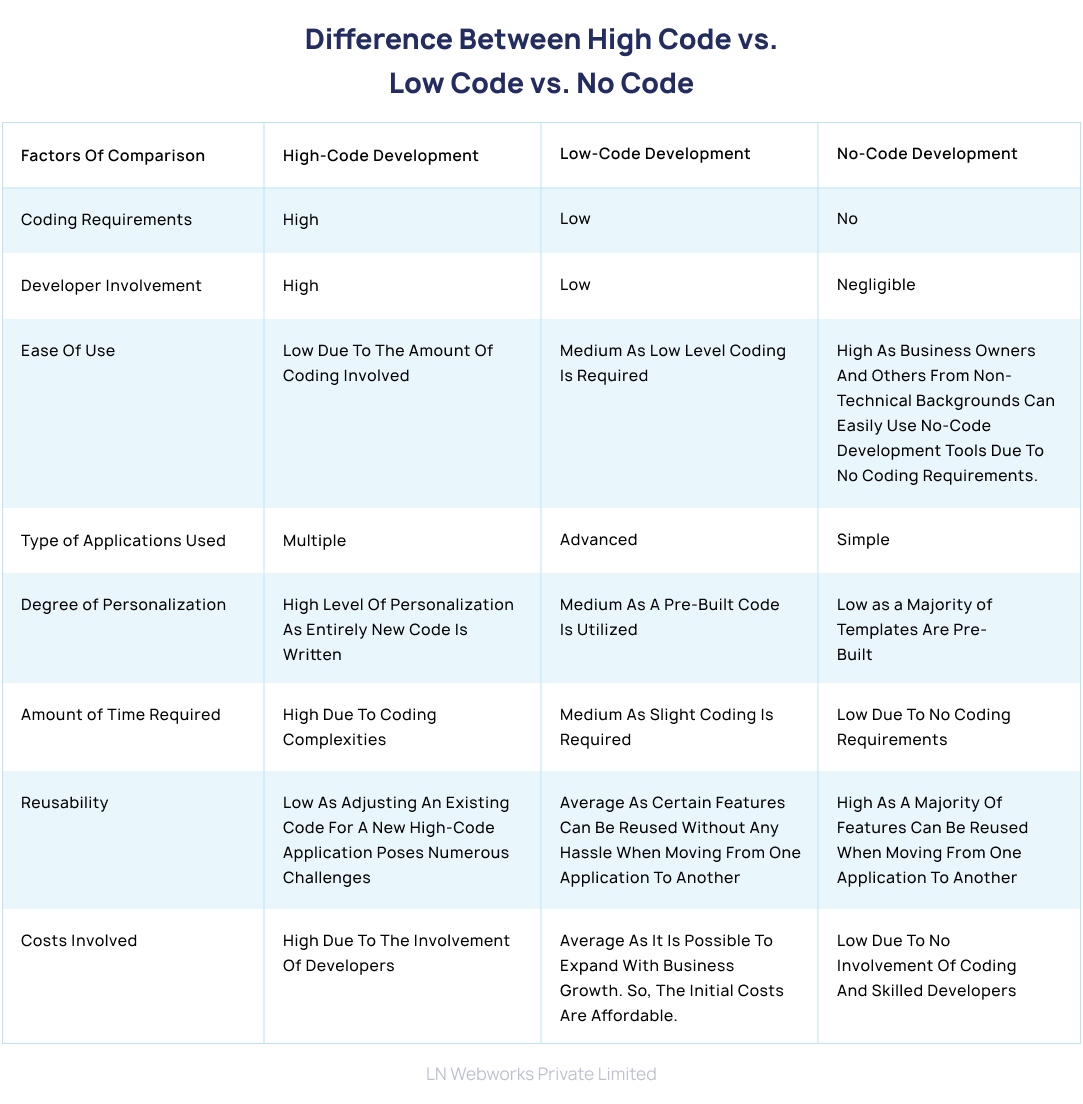Subscribe To Our NewsLetter
Share This Post:
High-code, low-code, and no-code are three different development approaches prevalent today. Whether we opt for Drupal development services or others, we are bound to come across them. Unlike in the old days, we do not have to exclusively rely on developers to make our dream projects a reality. With low-code and no-code development options, we can take charge ourselves or delegate the task to someone else. However, it is imperative to realize that it isn’t mandatory for us to choose only one of the development approaches.
We can also take a middle path and use a combination of all three to mitigate the limitations of each. For instance, if low-code and no-code development solutions limit the extent of customization in some places, we can opt for high-code development and so on. But, before we can make informed decisions, it is crucial to understand the three development approaches in detail. Let’s delve into them now.
High-Code, Low-Code, and No-Code: How They Differ From Each Other
High-Code Development
As the name suggests, high-code development involves a lot of coding. Needless to say, developers are at the forefront of the process. They have to write and deploy code for respective websites and applications. This approach is preferred in cases where code-driven experiences tied to code-deployment cycles and extensive customization are integral requirements.
The development team relies on JavaScript frameworks such as Angular and React to deliver the intended results. When it comes to content and data delivery, a headless CMS such as Drupal 10 or other API-driven services are usually behind it. No doubt, it is possible for teams to manage content and data from remote systems in times of need, but what is a bit problematic is that the interface and the actual experience depend largely on the developers.
What this means is that the web and application development team gets pre-equipped to manage the project. This leaves them with not much time to focus on innovation and the development of new features. All in all, high-code development is preferred for customization and code-driven experiences but it acts as an obstruction that prevents developers from focusing on other important tasks that demand their attention.
Low-Code Development
Web and application development teams leverage the power of low-code tools to create composable platforms and empower businesses with self-service tools that enable users to dictate the overall assembly of the experience. The best part of low-code development is that it uses pre-built components, functionalities, and design systems that can be repurposed for various experiences. This implies that these components can be easily reused for various other applications in the future.
Besides, as this development approach doesn’t involve high-level coding, it saves time and increases the speed of the process. A major distinguishing factor between high-code development and low-code development is that both the development and marketing teams are involved in the latter. The developers create components and the marketers assemble them in alignment with the requirements of the target audience and generate captivating customer experiences. This translates into enhanced customer satisfaction and improved reputation of the organization.
Initially, developers found it challenging to trust these solutions due to security concerns. However, with time, strategies have been developed to ensure proper security for applications and websites developed with a low-code approach. Consequently, a majority of developers now opt for low-code solutions fearlessly.
No-Code Development
As the name suggests, no-code development solutions do not require users to write even a single line of code. They can easily develop mobile applications and websites through forms, configurations, and other simple tools. Once developed, any department can use the tools effortlessly without seeking help from the developers.
The only troublesome aspect of these solutions is that they limit the extent of innovation and have limited potential when it comes to application in new business projects. This implies that they don't possess much flexibility and their expansion can be a costly affair. However, no code solutions make it simple for non-technical departments to handle technical stuff on their own. Besides, they also reduce the time and effort involved in the development process.
Major differences between high-code, low-code, and no-code development

Why a Collaborative Approach to Development is the Need of the Hour
Modern businesses have varied requirements that cannot be effectively met by getting limited to a single type of development approach. This calls for them to adopt a collaborative approach toward development wherein the advantages of no-code, low-code, and high-code development get leveraged to the maximum potential. For this to happen, it is imperative for entrepreneurs like you to opt for a hybrid CMS such as Drupal 10 that is seamlessly compatible with all three types of development processes.
With such software at their disposal, developers can exercise balanced control while not being overburdened. They can have limited control through high-code components and take support from other departments to maintain the hassle-free functioning of the app or website through low-code/no-code components. With the time saved, the development team can then conceive innovative ideas and products to take the organization on an upward spiral of growth.
Let’s Wrap Up
The bottom line is that high-code, low-code, and no-code development solutions all have their own advantages and disadvantages. Given the wide range of requirements of modern businesses, a single development approach is less likely to yield incredible results. Whereas, a combination of all three approaches can help organizations reap multiple benefits. The development teams can embed enormous customization into the products while saving time and effort. Besides, non-technical teams can seamlessly utilize software products without any developer assistance.
If you also aspire to implement a collaborative development approach but find it hard to decipher where and how to begin, LN Webworks, a reputed Drupal development company can assist you with the process. Our Drupal 10 experts can dig into your organization’s needs and build customized solutions for you. So, why wait? Contact us today.
Share This Post:
Author Information

LN Webworks
Your Drupal Solution PartnerLN Webworks have championed open-source technologies for nearly a decade, bringing advanced engineering capabilities and agile practices to some of the biggest names across media, entertainment, education, travel, hospitality, telecommunications and other industries.
Get Started With Us!
Related Articles
September 6, 2023
Drupal: The Unmatchable Tool for No-Code Development
June 13, 2023
Drupal as an Exceptional No-Code / Low-Code Website Builder
July 12, 2022



